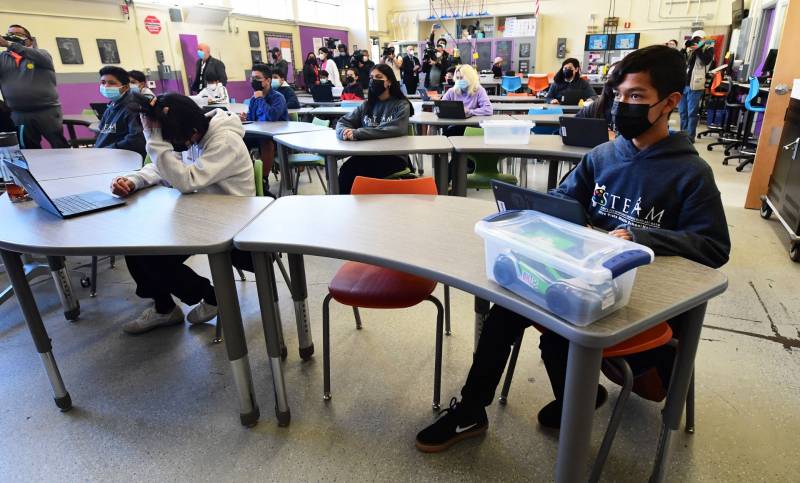“We can’t assume that, ‘OK, we’re back in school, it’s been a few months and now everyone should be back to normal.’ That is not the case,” said Hoover.
Kids need help when returning to school
Returning to school after months of isolation intensified the anxiety for some children. Teachers say students have greater difficulty focusing, concentrating or sitting still, and many need to relearn how to socialize and resolve conflicts face-to-face after prolonged immersion in screens.
Kids expected to pick up where they left off but some found friendships, and their ability to cope with social stress, had changed. Educators say they also see a concerning increase in apathy — about grades, how students treat each other and themselves — and a lot less empathy.
“I have never seen kids be so mean to each other in my life,” said Terrin Musbach, who trains teachers in mental health awareness and other social-emotional programs at the Del Norte Unified School District, a high-poverty district in rural Northern California. “There’s more school violence, there’s more vaping, there’s more substance abuse, there’s more sexual activity, there’s more suicide ideation, there’s more of every single behavior that we would be worried about in kids.”
Many states have mandated teacher training on suicide prevention over the last decade, and the pandemic prompted some to broaden the scope to include mental health awareness and supporting behavioral health needs.
But school districts nationwide also say they need more psychologists and counselors. The Hopeful Futures Campaign, a coalition of national mental health organizations, last month published a report that found most states are struggling with mental health support in schools. Only Idaho and the District of Columbia exceed the nationally recommended ratio of one psychologist per 500 students.
In some states, including West Virginia, Missouri, Texas and Georgia, there is only one school psychologist for over 4,000 students, the report says. Similarly, few states meet the goal of one counselor per 250 students.
President Joe Biden has proposed $1 billion in new federal funding to help schools hire more counselors and psychologists and bolster suicide prevention programs. That followed a rare pubic advisory in December from U.S. Surgeon General Vivek Murthy on “the urgent need to address the nation's youth mental health crisis."
In early 2021, emergency room visits in the U.S. for suspected suicide attempts were 51% higher for adolescent girls and 4% higher for adolescent boys compared to the same period in 2019, according to research cited in the advisory.
Since California began offering the Youth Mental Health First Aid course in 2014, more than 8,000 teachers, administrators and school staff have been trained, said Monica Nepomuceno, who oversees mental health programming at the California Department of Education.
She said much more needs to be done in the country’s largest state, which employs over 600,000 K-12 staff at schools.
The course helps distinguish typical adolescent ways of dealing with stress — slamming doors, crying, bursts of anger — from warning signs of mental distress, which can be blatant or subtle.
Those signs can include when a child talks about dying or suicide, but also can be more nuanced, like saying, “I can’t do this anymore,” or “I’m tired of this,” said Tramaine EL-Amin, a spokesperson for the National Council for Mental Wellbeing. More than 550,000 K-12 educators across the country have taken the Youth Mental Health First Aid course since it launched in 2012, she said.
Changes in behavior could be cause for concern — a child who stops a sport or activity they were passionate about without replacing it with another one; a typically put-together child who starts to look regularly unkempt; a student whose grades plummet or who stops handing in homework; a child who eats lunch alone and has stopped palling around with their friends.
After noticing something might be wrong, the course teaches that the next step is to ask the student without pressuring or casting judgment and letting them know you care and want to help.
“Sometimes an adult can ask a question that causes more harm than good,” said Luna-Herrera, the social studies teacher at California City Middle School, a two-hour drive into the desert from Los Angeles.
He took the course in spring 2021 and two weeks later put it to use. It was during distance learning and a student had failed to show up for online tutoring, but he spotted her chatting online on the school’s distance learning platform, having a heated dispute with her then-boyfriend. Luna reached out to her privately.
“I asked her if she was OK,” he said. Little by little, the girl told Luna-Herrera about problems with friends and her boyfriend and problems at home that left her feeling alone and desperately unanchored.
The course tells adults to ask open-ended questions that keep the conversation going, and not to project themselves into an adolescent’s problems with comments like: "You'll be fine," "It's not that bad," "I went through that," "Try to ignore it." What might seem trivial to an adult can feel overwhelming for a young person, and failure to recognize that can be a conversation stopper.
The 12-year-old told Luna-Herrera she had considered hurting herself. “Is that a recurring thought?” he asked, recalling how his heart started racing as she revealed her suicide plan.
Like CPR first-aid training, the course teaches how to handle a crisis: Raise the alarm and get expert help. Do not leave a person contemplating suicide alone. As Luna-Herrera continued talking to the girl, he texted his school superintendent, who got the principal on the line. They called 911 and police rushed to the home, where they spoke to the girl and her mother, who was startled and unaware.

